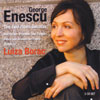Enescu (The) Two Piano Sonatas; Nocturne; Prelude and Fugue
Absorbing set from a player dedicated to Enescu’s subtle piano world
View record and artist detailsRecord and Artist Details
Composer or Director: George Enescu
Genre:
Instrumental
Label: Avie
Magazine Review Date: 6/2006
Media Format: Super Audio CD
Media Runtime: 94
Mastering:
Stereo
DDD
Catalogue Number: AV2081

Tracks:
| Composition | Artist Credit |
|---|---|
| Prelude and Fugue |
George Enescu, Composer
George Enescu, Composer Luiza Borac, Piano |
| Nocturne |
George Enescu, Composer
George Enescu, Composer Luiza Borac, Piano |
| Scherzo |
George Enescu, Composer
George Enescu, Composer Luiza Borac, Piano |
| Pièce sur le nom de Fauré |
George Enescu, Composer
George Enescu, Composer Luiza Borac, Piano |
| Sonata for Piano No. 1 |
George Enescu, Composer
George Enescu, Composer Luiza Borac, Piano |
| Sonata for Piano No. 2 |
George Enescu, Composer
George Enescu, Composer Luiza Borac, Piano |
Author: Rob Cowan
If you need evidence of Enescu’s intellectual integrity, consider the case of his second piano sonata, which although locked away in his head (he never got round to writing it down) was still granted an opus number. For Enescu the fact that it was imagined was reality enough. Mind you, the sonata wasn’t alone: ‘If I could put down on paper everything I had in my head,’ he once said to a colleague, ‘it would take hundreds of years.
The piano music is fairly typical, tone-painting that conjures the subtlest shades, expansive and exotic and, in the hands of a musician as dedicated as Luiza Borac, utterly absorbing. The Prelude and Fugue dates from the early years of the last century when Enescu was still in his early twenties, the prelude hazily evocative, the fugue – all six minutes of it – among the coolest, most relaxed examples of the form you’re ever likely to hear. The slightly later D major Nocturne again takes its time (20 minutes), anticipating as it does the mystical world of Enescu’s maritime tone-poem Vox maris.
Avie’s excellent annotator Martin Anderson likens the early Scherzo (1896) to Brahms; a meaningful pointer, though to my ears Saint-Saëns seems even nearer the mark. As to the sonatas, Borac writes eloquently of the tragedy and sadness that fills the First (1925), with special reference to the Romanian word ‘Dor’ – ‘almost untranslatable,’ she says, settling (roughly) for ‘longing’, ‘nostalgia’, ‘lovesickness’. The driven central Scherzo, with its shimmering repeated notes, hints at the contemporaneous American scene (Gershwin) as well as what Bartók and Martin≤ were doing nearer to home. More Bartókian still is the first movement of the Third Sonata (1933), so prophetic of the Romanian dances that end Mikrokosmos, the folk-inspired second movement very like Enescu’s own Third Violin Sonata, which is also true of the declamatory writing at the very end of the work.
Borac’s only substantial rival is Dinu Lipatti in the Third Sonata (EMI): fabulous playing in crumby sound, though the subtleties in her own touch should offer pleasure enough. She obviously loves the music and to own these records is to own a standing invitation to a world where impressionism, musical folklore and emotional generosity all play a crucial role. For although Enescu’s fertile brain yielded but a fraction of what it held in store, the manifest legacy is endlessly fascinating and repays close scrutiny. Fine piano sound.
The piano music is fairly typical, tone-painting that conjures the subtlest shades, expansive and exotic and, in the hands of a musician as dedicated as Luiza Borac, utterly absorbing. The Prelude and Fugue dates from the early years of the last century when Enescu was still in his early twenties, the prelude hazily evocative, the fugue – all six minutes of it – among the coolest, most relaxed examples of the form you’re ever likely to hear. The slightly later D major Nocturne again takes its time (20 minutes), anticipating as it does the mystical world of Enescu’s maritime tone-poem Vox maris.
Avie’s excellent annotator Martin Anderson likens the early Scherzo (1896) to Brahms; a meaningful pointer, though to my ears Saint-Saëns seems even nearer the mark. As to the sonatas, Borac writes eloquently of the tragedy and sadness that fills the First (1925), with special reference to the Romanian word ‘Dor’ – ‘almost untranslatable,’ she says, settling (roughly) for ‘longing’, ‘nostalgia’, ‘lovesickness’. The driven central Scherzo, with its shimmering repeated notes, hints at the contemporaneous American scene (Gershwin) as well as what Bartók and Martin≤ were doing nearer to home. More Bartókian still is the first movement of the Third Sonata (1933), so prophetic of the Romanian dances that end Mikrokosmos, the folk-inspired second movement very like Enescu’s own Third Violin Sonata, which is also true of the declamatory writing at the very end of the work.
Borac’s only substantial rival is Dinu Lipatti in the Third Sonata (EMI): fabulous playing in crumby sound, though the subtleties in her own touch should offer pleasure enough. She obviously loves the music and to own these records is to own a standing invitation to a world where impressionism, musical folklore and emotional generosity all play a crucial role. For although Enescu’s fertile brain yielded but a fraction of what it held in store, the manifest legacy is endlessly fascinating and repays close scrutiny. Fine piano sound.
Discover the world's largest classical music catalogue with Presto Music.

Gramophone Digital Club
- Digital Edition
- Digital Archive
- Reviews Database
- Full website access
From £8.75 / month
Subscribe
Gramophone Full Club
- Print Edition
- Digital Edition
- Digital Archive
- Reviews Database
- Full website access
From £11.00 / month
Subscribe
If you are a library, university or other organisation that would be interested in an institutional subscription to Gramophone please click here for further information.




